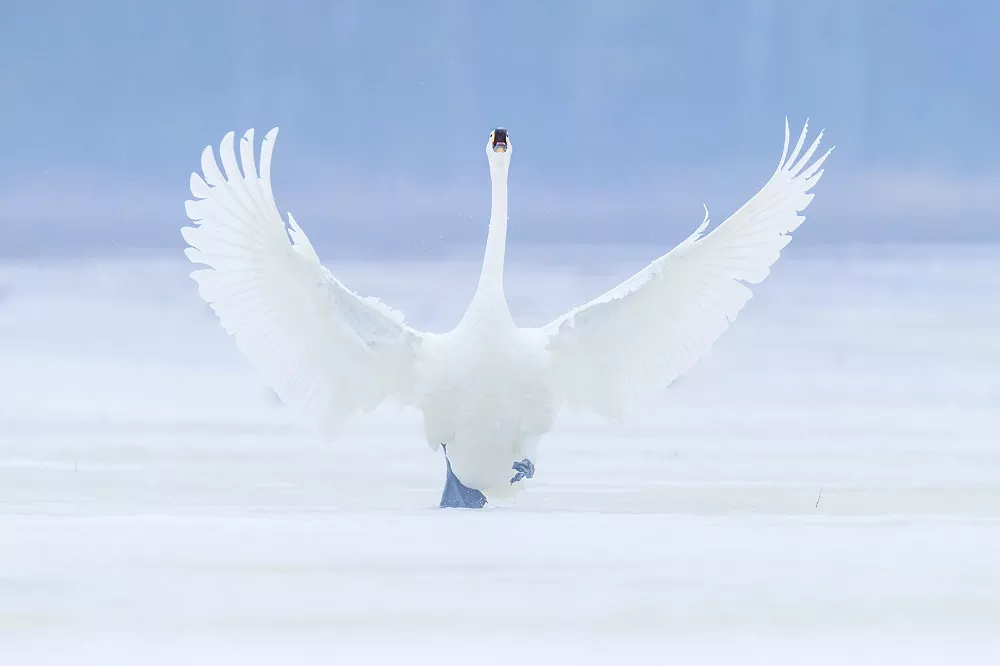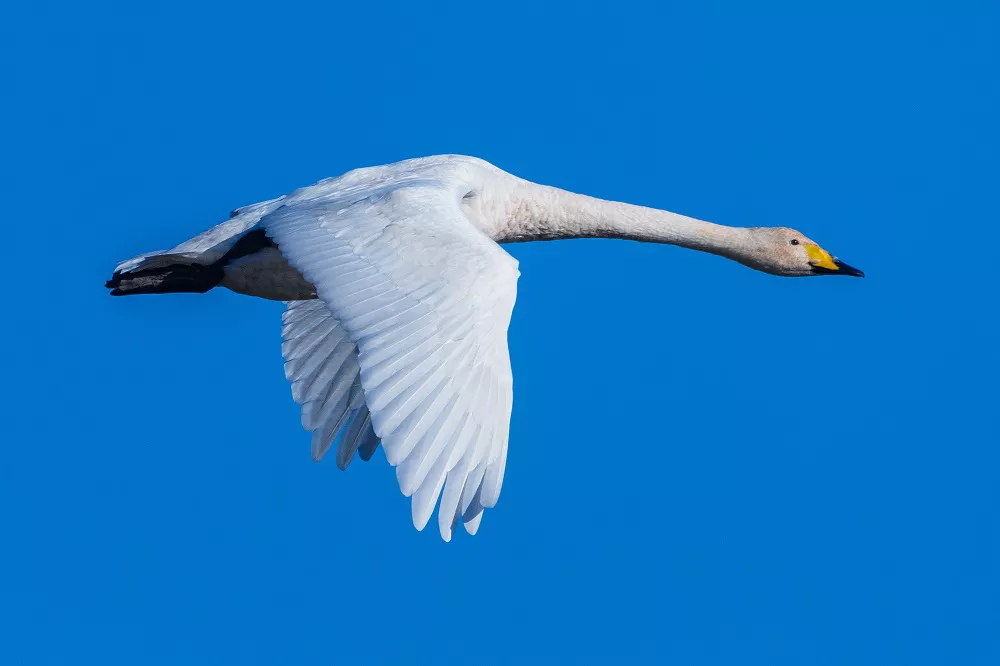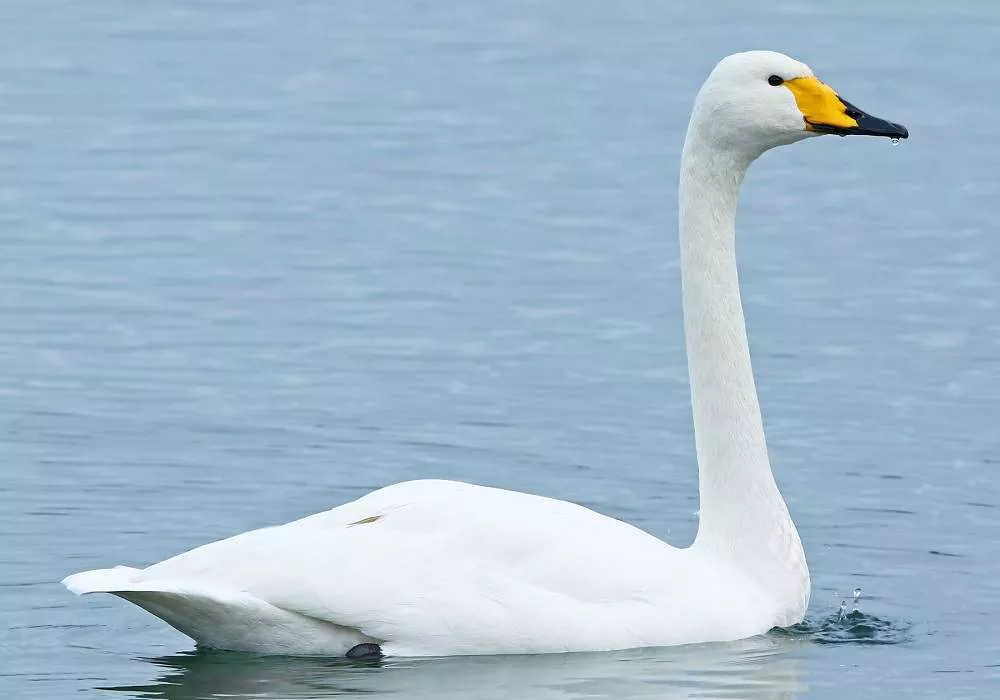The national bird of Finland is the Whooper Swan (Cygnus cygnus). This elegant, vocal waterbird holds symbolic, ecological, and cultural importance in Finland. In Finnish, it is called laulujoutsen, which means “singing swan.” Over decades, its story has been one of decline, protection, and recovery. Today, it is more than a bird—it is a living emblem of Finland’s northern nature, resilience, and respect for wildlife.
Recognized as one of Europe’s most beautiful waterfowl, the Whooper Swan is not just a bird—it’s a symbol of national pride. The species was chosen as Finland’s national bird in 1981, after a nationwide vote organized by the Finnish Nature Association. The choice reflects both the swan’s comeback from near-extinction and its enduring place in Finnish identity.
This article explores the Whooper Swan’s characteristics, habitat, migration patterns, symbolism, and conservation—showing why it stands as a timeless emblem of Finland.
Physical Characteristics of the Whooper Swan
The Whooper Swan is one of the largest and most recognizable swan species in the world. Adults are strikingly white, with long necks and powerful wings that span up to 2.75 meters (9 feet).
Size and Weight
- Length: 140–165 cm (55–65 inches)
- Wingspan: 205–275 cm (6.7–9.0 feet)
- Weight: 9–12 kilograms (20–26 pounds)
Males are usually slightly larger than females, though both sexes appear similar. The bird’s black and yellow bill is its most distinctive feature—the yellow extends in a wedge shape toward the tip, helping to distinguish it from the Mute Swan (Cygnus olor) and the Tundra Swan (Cygnus columbianus).
Behavior and Flight
Whooper Swans are strong fliers and can reach speeds of up to 90 km/h (56 mph). During migration, they fly in V-shaped formations, calling to each other in a loud, trumpet-like voice. These calls—often described as both mournful and musical—are a hallmark of Finnish spring and autumn skies.
When swimming, they move gracefully, their long necks held upright. On land, they walk slowly but purposefully.
Natural Habitat in Finland
Finland’s countless lakes, marshes, and tundra landscapes make an ideal home for the Whooper Swan.
Breeding Grounds
The Whooper Swan breeds mainly in northern Finland, especially in Lapland and central lake regions. They prefer quiet, shallow lakes with abundant vegetation, where they can build large nests near the water’s edge.
Each breeding pair claims a small territory and fiercely defends it from intruders. Swans are monogamous and often mate for life, returning to the same nesting site each year.
Wintering and Migration
During the harsh Finnish winter, most Whooper Swans migrate south to coastal regions of Western Europe, including:
- The Baltic Sea coasts
- Scotland and Ireland
- The Netherlands
- Denmark
Some swans remain in southern Finland if open water is available throughout the winter. The migration typically begins in October and ends when they return in March or April, signaling the arrival of spring.
Breeding and Life Cycle
Nesting
Whooper Swans build large nests made of moss, reeds, and grasses—sometimes reaching over 1 meter in diameter. The female (pen) lays 4–7 eggs, and both parents take turns incubating them for about 36 days.
Cygnets and Parental Care
The hatchlings, called cygnets, are covered in grey down and can swim within a few hours of birth. They stay with their parents throughout the summer, learning to feed and fly.
By October, the young swans are strong enough to migrate alongside their parents. Family groups often remain together until the next breeding season.
Lifespan
In the wild, Whooper Swans can live up to 20 years, though some reach over 30 years in captivity. Their strong pair bonds and cooperative parenting are key to their survival.
Symbolism and Cultural Significance in Finland
A Symbol of Purity and Renewal
The Whooper Swan holds deep emotional and cultural meaning in Finland. Its return each spring is seen as a sign of hope, renewal, and the triumph of life over winter’s darkness.
Because of Finland’s long winters and short summers, the swan’s migration is more than a natural event—it’s a reminder of the rhythm of Finnish life, tied to nature’s cycles.
Mythology and Folklore
In Finnish mythology, swans are associated with beauty, mystery, and the soul’s journey. The Kalevala—Finland’s national epic—mentions swans in connection with the mythical Lake Tuonela, where a swan guards the realm of the dead. The image of the “Swan of Tuonela” inspired the famous tone poem by Finnish composer Jean Sibelius, one of Finland’s most iconic musical works.
In this context, the Whooper Swan represents both life and death, a messenger between worlds, and a symbol of spiritual purity.
Modern National Symbol
When the Whooper Swan was chosen as Finland’s national bird in 1981, it was celebrated as a comeback story. The species had nearly disappeared from southern Finland due to hunting and habitat loss in the early 20th century. Its successful recovery symbolized Finland’s commitment to conservation and the strength of nature.
Today, the swan appears in Finnish art, coins, stamps, and official emblems, reflecting its deep integration into national identity.
Diet and Feeding Habits
Whooper Swans are herbivores, feeding mainly on aquatic plants, roots, and stems. Their diet varies depending on the season and habitat.
In Summer
They eat submerged vegetation such as pondweeds, water lilies, and grasses. They use their long necks to reach underwater plants and sometimes feed on land in nearby meadows.
In Winter
During migration or in wintering areas, they often feed in farmlands and wetlands, consuming leftover grains, potatoes, or grasses.
Because they are large birds with high energy needs, they spend much of their day feeding and maintaining body condition for migration.
The Whooper Swan’s Calls
The Whooper Swan’s trumpet-like calls are among the most distinctive sounds of Finnish nature. Their voice is clear and resonant, often heard over long distances during flight.
In Finnish literature and poetry, the swan’s call is described as both melancholic and beautiful, symbolizing solitude, longing, and peace. It has inspired composers, writers, and artists for centuries, most famously Jean Sibelius, whose Swan of Tuonela remains a masterpiece of Finnish classical music.
Conservation and Recovery
From Decline to Protection
At the beginning of the 20th century, Whooper Swans were nearly extinct in southern Finland. Overhunting, egg collection, and the draining of wetlands drastically reduced their numbers. By the 1940s, fewer than 30 breeding pairs were recorded.
The Finnish government introduced full legal protection in 1934, followed by extensive habitat restoration projects. Public awareness campaigns helped shift attitudes toward protecting wildlife.
Population Recovery
Thanks to conservation efforts, the Whooper Swan population grew dramatically:
- 1950s: ~50 breeding pairs
- 1980s: ~2,000 pairs
- Today: Over 10,000 breeding pairs across Finland
The species is now classified as Least Concern by the International Union for Conservation of Nature (IUCN), though continued habitat protection is essential to maintain its success.
Key Conservation Measures
- Protection of breeding wetlands and nesting areas
- Monitoring migration routes
- Public education and ecotourism
- Collaboration with European conservation networks
The Whooper Swan’s recovery is considered one of Finland’s greatest environmental achievements.
The Whooper Swan in Finnish Art and Identity
The swan’s pure white plumage and serene demeanor have long made it a favorite subject in Finnish visual arts, literature, and national symbols.
Artistic Representations
Artists such as Akseli Gallen-Kallela and Eero Järnefelt often depicted swans as emblems of freedom and nature’s purity. Their paintings highlight the harmony between the swan and Finland’s pristine landscapes.
Music and Literature
Sibelius’s The Swan of Tuonela portrays the swan as a mysterious figure gliding over dark waters—a metaphor for death and beauty. In Finnish poetry, the swan often appears as a symbol of melancholic beauty, purity, and national pride.
Modern Usage
Today, the Whooper Swan appears on Finnish coins, aviation logos, and tourism campaigns. Its image communicates tranquility, natural beauty, and national unity.
Some Fun Facts About the Whooper Swan
The Whooper Swan inspired the famous ballet “Swan Lake”, composed by Tchaikovsky.
Their wings make a distinctive whistling sound during flight.
They can fly nonstop for over 1,000 kilometers during migration.
In Finnish, the Whooper Swan is called “Laulujoutsen,” meaning “singing swan.”
They are featured on Finland’s 1-Euro coin, symbolizing the nation’s natural beauty.
Why the Whooper Swan Represents Finland Perfectly
The Whooper Swan embodies everything Finland values—freedom, endurance, purity, and harmony with nature. Its resilience mirrors Finland’s national spirit, enduring harsh winters and returning each spring in triumph.
Its haunting call, graceful flight, and deep cultural roots make it more than a national bird—it is a living emblem of Finnish identity. Whether gliding over Lapland’s lakes or appearing on national coins, the Whooper Swan continues to remind Finns of the importance of preserving their pristine environment for future generations.
Conclusion
The Whooper Swan is more than a magnificent bird—it is the heart of Finland’s natural and cultural identity. From near extinction to national symbol, its story reflects the nation’s dedication to protecting wildlife and respecting the environment.
Frequently Asked Questions (FAQ)
Q1: What is the national animal of Finland?
The national animal of Finland is the brown bear (Ursus arctos). It symbolizes strength, courage, and the deep connection between Finns and their vast natural landscapes. The brown bear is also featured in Finnish folklore and mythology as a respected and powerful creature.
Q2: What is the national flower of Finland?
The lily-of-the-valley (Convallaria majalis), known as kielo in Finnish, was chosen as Finland’s national flower due to its widespread presence and cultural significance. It blooms in early summer across moist woodlands and gardens throughout the country and is celebrated for its sweet scent and delicate white bell-shaped flowers. Despite its beauty, all parts of the plant, including the bright red berries, are poisonous.
Q3: What is the national tree of Finland?
The silver birch (Betula pendula) was selected as Finland’s national tree in 1988 following a public vote. Revered for its striking white bark and graceful drooping branches, it holds deep cultural importance. Traditionally, Finns have used birch sap as a health drink, its bark for crafting items like baskets and shoes, and its young branches for sauna whisking. It is also a common decorative element during Midsummer celebrations.




 Facebook
Facebook  Instagram
Instagram  Youtube
Youtube 